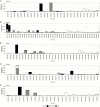The protected tree Dimorphandra wilsonii (Fabaceae) is a population of inter-specific hybrids: recommendations for conservation in the Brazilian Cerrado/Atlantic Forest ecotone
- PMID: 32277237
- PMCID: PMC7304468
- DOI: 10.1093/aob/mcaa066
The protected tree Dimorphandra wilsonii (Fabaceae) is a population of inter-specific hybrids: recommendations for conservation in the Brazilian Cerrado/Atlantic Forest ecotone
Abstract
Backgrounds and aims: Dimorphandra wilsonii Rizzini, a critically endangered and protected tree, has a restricted distribution in the ecotone between the Cerrado and the Atlantic Forest in south-eastern Brazil. In this area, it co-occurs with D. mollis Benth., a common tree from the Cerrado, and D. exaltata Schott., a rare tree from the Atlantic Forest. Previous studies of D. wilsonii indicated heterozygosity excess at the individual level. Field observation of some intermediate phenotypes between D. wilsonii and both congeners suggests hybridization of D. wilsonii with D. mollis and/or D. exaltata. Here, we tested the hypothesis that D. wilsonii may have originated from hybridization between D. exaltata and D. mollis. We also performed cytogenetic analysis to examine if the heterozygosity excess could be explained by polyploidy in D. wilsonii.
Methods: We evaluated the genetic diversity and population structure of D. wilsonii using 11 nuclear simple sequence repeats (SSRs) genotyped in 152 individuals sampled across the taxon's range. We performed comparative genetic analyses using overlapping SSR markers between D. wilsonii and previously published SSR data in D. mollis and D. exaltata to subsequently perform a series of allelic comparisons, multivariate and Bayesian analysis.
Key results: Our results suggest that D. wilsonii individuals are most likely to correspond to F1 hybrids between D. exaltata and D. mollis. Cytogenetic analysis indicated that D. wilsonii is diploid with the same chromosome number as D. mollis (2n = 2x = 28).
Conclusions: Our study raises questions about the taxonomic status and the evolutionary future of D. wilsonii. We suggest that the conservation and management strategy for D. wilsonii should be revised and that it should take into account both parental Dimorphandra species in the ecotone, with special emphasis on the threatened D. exaltata. Finally, this study highlights the value of genetic information for the design of conservation strategies.
Keywords: Dimorphandra; Dimorphandra wilsonii; Atlantic Forest; Cerrado; conservation genetics; ecotone; hybridization.
© The Author(s) 2020. Published by Oxford University Press on behalf of the Annals of Botany Company. All rights reserved. For permissions, please e-mail: journals.permissions@oup.com.
Figures





References
-
- Abbott RJ. 2017. Plant speciation across environmental gradients and the occurrence and nature of hybrid zones. Journal of Systematics and Evolution 55: 238–258.
-
- Abbott R, Albach D, Ansell S, et al. . 2013. Hybridization and speciation. Journal of Evolutionary Biology 26: 229–246. - PubMed
-
- Aksoy S, Almeida-Val VMF, Azevedo VCR, et al. . 2013. Permanent genetic resources added to molecular ecology resources database 1 October 2012–30 November 2012. Molecular Ecology Resources 13: 341–343. - PubMed
-
- Allendorf FW, Leary RF, Spruell P, Wenburg JK. 2001. The problems with hybrids: setting conservation guidelines. Trends in Ecology and Evolution 16: 613–622.
Publication types
MeSH terms
LinkOut - more resources
Full Text Sources

